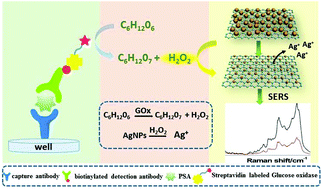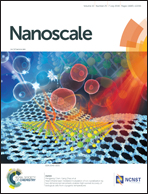Silver nanoparticles deposited on graphene oxide for ultrasensitive surface-enhanced Raman scattering immunoassay of cancer biomarker†
Abstract
Graphene oxide (GO) exhibits distinctive Raman scattering features for its high frequency D (disordered) and tangential modes (G-band), which are characteristically sharp at 1580 cm−1 and 1350 cm−1, respectively, but are too weak for sensitive quantitation purposes. By depositing silver nanoparticles on the surface of GO in this contribution, both D and G bands of GO become enhanced. The enzyme label of this method controls the dissolution of silver nanoparticles on the surface of GO through hydrogen peroxide which is produced by the oxidation of the enzyme substrate. With the dissolution of the silver nanoparticles a greatly decreased SERS signal of GO was obtained. This strategy involves dual signal amplification of the enzyme and nanocomposites to improve the detection sensitivity. As a proof of concept, prostate specific antigen (PSA), a biomarker for prostate cancer, is successfully detected as a target by forming a sandwich structure in immunoassay. The SERS immunoassay possesses excellent analytical performance in the range 0.5 pg mL−1 to 500 pg mL−1 with a limit of detection of 0.23 pg mL−1, making the detection of PSA serum samples from prostate cancer patients satisfactory, demonstrating that the sensitive enzyme-assisted dissolved AgNPs SERS immunoassay of PSA has potential applications in clinical diagnosis.



 Please wait while we load your content...
Please wait while we load your content...